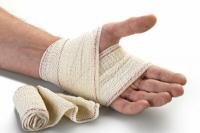How many bones do humans have?
The human body has an extensive skeleton with many bones that perform different functions. Depending on how they function, they differ in shape and structure. But how many bones do we actually have?

Interesting facts about human bones:
- An adult human has 206 to 212 bones.
- The largest bone is the femur.
- The smallest bone is the stapes in the ear.
- The bones are divided into four main categories: long (thigh bones), short (carpal bones), irregularly shaped (vertebrae), and plate-like (skull bones).
- The different information about the number of bones in the human body varies because some people have a few more bones and also because some cartilage ossifies with age.
- Bones are about 60 to 70% inorganic minerals, 10 to 15% water and 20 to 25% organic matter.
- A person who is 180cm tall and weighs 75kg has a bone weight of approx. nine kg.
Broken bone - healing goes like this
The bone breaks. After the x-ray he is put in a plaster cast and after a few weeks he heals and...
The Physiology of Bones:
- The shape and statics of the human body are determined by the skeleton, i.e. the bones. The bone tissue itself is not static, it is adapted to the requirements, it reacts to stress stimuli and can increase bone density if necessary.
- The bone structure, including tendons, ligaments, joints and muscles, is responsible for the body's biomechanical capabilities. This is the only way movement is possible.
- Bones protect the internal organs, the brain is protected by the skull bones, the organs such as the heart, lungs, liver. They are well protected by the ribcage with the ribs and the bony thorax.
- Calcium (mineral salt) is stored in bone tissue and released again when necessary. The bone substance is able to bind heavy metal ions to a certain extent and filter them out of the bloodstream. In addition, bones protect the bone marrow from radiation due to their high density. Bone density peaks at around 30 years of age and then decreases continuously, especially if there is a lack of exercise.
- After menopause, women are particularly at risk of developing osteoporosis, in which bone density decreases to such an extent that fractures can occur from even the smallest of bruises. Exercise is a good prevention here because the bones adapt to the stress and develop more density when they are required.
- Blood is formed in the bone marrow; in babies the red bone marrow can still be found in all bones; in adults this is reduced to the plates and short bones.
- Thanks to their lightweight construction principle, bones perfectly create the right balance between the lowest possible weight and the highest possible stability. This structure with the help of calcium and phosphorus is a great development of nature.
- A bone can grow back together on its own if it is broken, which is also nature's intelligent solution.
With this knowledge, you may now look at your body and skeleton with completely different eyes.
How helpful do you find this article?


